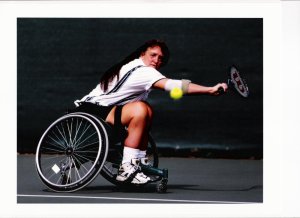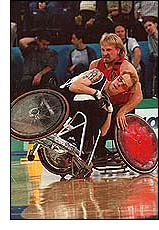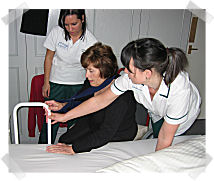Shoulder Surgery in Paraplegics
Lennard Funk, 2005
The shoulder is the most common site of pain reported by the wheelchair population. More than half of all people with weightbearing shoulders (wheelchair users and crutch users) develop shoulder pain [Gellman, 1988; Sie, 1992; Finley, 2004 ]. This usually involves the subacromial region and rotator cuff, with rotator cuff tears, degenerative changes, and other pathologies about the coracroacromial arch commonly found [Boninger, 2001; Escobedo, 1997]. The most common problems we have seen with weighbearing shoulders have been subacromial impingement (48%), rotator cuff tears (34%), biceps pathology (28%)(associated with cuff tears usually) and acromioclavicular joint arthritis (12%).

The length of weightbearing and wheelchair use correlates with the development of shoulder pain (that is, the longer you have been using a wheelchair the more likely you are to develop pain). However, no difference has been found between athletes and non-athletes, so participation in sports does not make one more prone to shoulder problems [Finley, 2004]
Weighbearing shoulders are more prone to pathology as a result of:
- the repetitive nature of wheelchair propulsion
- the high-strength requirements placed on the shoulder muscles
- loading of the joints at extremes of motion
- muscular weakness or imbalance
- high internal joint forces and abnormal stresses applied to the subacromial area during weightbearing through the shoulder, wheelchair propulsion and transfers.
It is essential to exclude a rotator cuff tear in paraplegics, as the rotator cuff is essential to normal function and strength of the shoulder. Optimum strength and function is required for both mobility and hand functions. A rotator cuff tear can be extremely disabling. A cuff tear is most easily diagnosed with an ultrasound scan, which can be done at the same time as the first consultation. If a rotator cuff tear is found, this will require repair.
Shoulder Surgery in Weight-bearing shoulders
Shoulder surgery for someone reliant on their shoulders for mobility is associated with much anxiety, particularly if you will need to keep your arm immobile in a sling for a few weeks after the operation (such as for a rotator cuff repair). People are also extremely concerned about complications of the surgery as they are so reliant on their shoulders.
1. The surgery:
Of course all surgery is associated with complications, but with arthroscopic surgery many of these complications are much reduced. Since there is no damage to muscles to gain access to the shoulder there is less chance of muscle failure and infection. However, the surgery is more technically demanding and should be undertaken by a surgeon experienced in the techniques.
2. After the surgery:
Experienced occupational therapists can be extremely helpful to arrange home aides pre-operatively and advice on living with a sling. For more details Click here for a Patient's experience and Occupational Therapy input.
Useful links:


